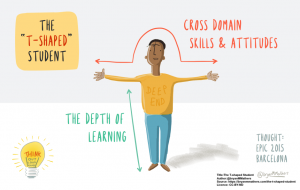9x9x25 #8: Breaking things
I’ve been thinking and doing some reading about assessment and feedback, particularly in light of the ‘disposable assignment’ conversation. If you haven’t read anything on this topic, I’d suggest David Wiley’s Open Pedagogy and Michael Paskevicius’ Killing the Disposable Assignment as a starting point. I’ve been contemplating just what a disposable assignment entails, looks like, or feels like. Can a blog post feel like a disposable assignment? Could a podcast be considered disposable? What qualities do non-disposable assignments inherently contain?
I’ve just read a blog post titled “If it ain’t broke, break it” by Chad Flinn, an electrical instructor at the BC Institute of Technology. The title caught my attention. There was one question asked in this post “Was I preparing them for a life in the trades?” which I rephrased to “Am I preparing my students for a life as a critically digitally literate teacher?” The content in the article, along with reflections on assessment, are sitting in my head and breaking some previously held ideas apart.
 I’ve listened to my fellow OEFellow Laura Killam talking about her explorations into ungrading in her teaching context as an instructor in a nursing program. She writes eloquently on her blog at Insights from Nurse Killam, where she posted an image I’ve had on my computer desktop as a reminder of what I’m trying to accomplish. It’s Bryan Mather’s graphic of the T-shaped student.
I’ve listened to my fellow OEFellow Laura Killam talking about her explorations into ungrading in her teaching context as an instructor in a nursing program. She writes eloquently on her blog at Insights from Nurse Killam, where she posted an image I’ve had on my computer desktop as a reminder of what I’m trying to accomplish. It’s Bryan Mather’s graphic of the T-shaped student.
There were a few sessions at the recent eCampus Ontario TESS18 that also caught my attention. One was presented by students in a biology class, in the field of neuroscience, where the instructor required students to create a visual abstract. This was in conjunction with, and a supplement for, the text based article abstracts we’ve all used when scanning academic articles. Students were required to re-image the abstract and the research article using an infographic style document. Despite challenges, perceptions, and issues in process and production, the student presenters shared their success with this task and the impact on their learning while completing this assignment. This left a legacy of thought in my brain, with links to the tasks I require students to complete in my courses.
So, with all these ideas ricocheting inside my mind, there’s bound to be some breakage. I’m struggling through a re-design of a course syllabus, which is due in a week. I’m trying to put the pieces back together in some semblance of a course design, but it’s still not coming together.
- There are the eCampus Ontario Extend modules to consider – this could be a sandbox space for my students to explore and apply digital fluencies, but will it be enough and will these skills transfer to the K-12 classrooms in which my students will teach?
- There are the freely accessible Lynda.com courses available where students can pick and chose their learning options while applying critical digital literacies to their learning, but is there something for everyone? I haven’t explored this digital space to see what learning opportunities might fit to the context in which I’m teaching.
- There’s the ISTE teaching standards and potential for my students to openly explore how these factors can be integrated into their teaching practice, but will this be too open ended and unstructured for my students?
- What evidence of learning or verification of competency will be required and how will assessment be conducted? I like the format of the google form submissions suggested in Chad Flinn’s blog post, but I’m not sure how that will fit into the course I’m designing.
As you can see, there’s more breakage than re-visions, edits or building. That’s coming, I’m sure. Here’s hoping it’s not a hodge-podge result that only makes sense to me, while looking like a Picasso-like rendition of a learning mosaic.


